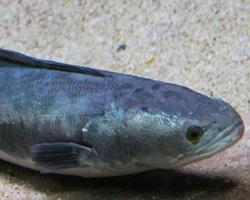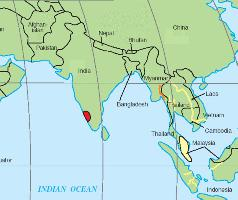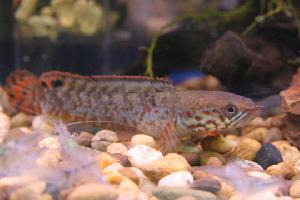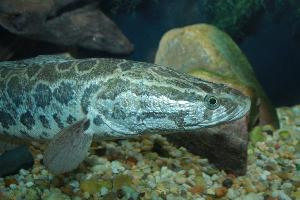
Weights and measures
| Length | 1 m |
|---|---|
| Weight | 20 kg |
Animal description
The Giant Snakehead (Channa micropeltes), also known as the red snakehead, Toman fish, or Ikan Toman in some regions, is a freshwater fish species native to Southeast Asia. It is one of the largest members of the snakehead family, a group of fish known for their elongated bodies, scale-covered heads resembling that of a snake, and their ability to breathe atmospheric air using a specialized labyrinth organ. This adaptation allows them to survive in low-oxygen environments and even to travel short distances on land, making them a highly resilient and adaptable species.Adult Giant Snakeheads can reach impressive sizes, often growing up to 1 meter (about 3 feet) in length, though there are reports of individuals exceeding this size, with weights surpassing 20 kilograms (about 44 pounds). Their bodies are elongated and muscular, with a broad, flattened head and large mouth equipped with sharp, canine-like teeth, enabling them to seize and hold onto their prey effectively.
The coloration of the Giant Snakehead varies with age. Juveniles display striking colors with bright red and orange tones along their body, accompanied by a series of black stripes, making them quite distinctive. As they mature, their coloration changes to a more subdued pattern, typically dark green, brown, or black, which helps them blend into their natural habitats. This camouflage is crucial for their role as ambush predators.
Giant Snakeheads are apex predators in their ecosystems, preying on a wide variety of food sources including fish, crustaceans, and sometimes even small mammals and birds that venture close to the water's edge. Their predatory nature, combined with their ability to breathe air and migrate across land, has enabled them to colonize a variety of freshwater habitats. They are commonly found in slow-moving streams, rivers, lakes, and swamps across Southeast Asia, including countries like Thailand, Malaysia, Indonesia, and parts of Indochina.
Despite their fascinating biology and important role in their native ecosystems, Giant Snakeheads are often viewed negatively due to their invasive potential when introduced to non-native environments. In areas where they have no natural predators, they can significantly disrupt local ecosystems by outcompeting or preying upon native species. This has led to strict regulations regarding their importation, transportation, and release in many countries outside their native range.
Reproduction in Giant Snakeheads involves the laying of eggs in nests guarded by both parents, showcasing a rare level of parental care among fish. The male often guards the nest aggressively, while the female patrols the surrounding area. This protective behavior ensures a higher survival rate for their offspring, contributing to their success as a species.
In some parts of Asia, the Giant Snakehead is not only respected for its prowess as a predator but also valued as a food source and for recreational fishing. Its firm, white flesh is considered a delicacy, and the challenge of catching such a powerful and aggressive fish makes it a prized target for anglers.
In conclusion, the Giant Snakehead is a remarkable species, admired and feared for its size, predatory efficiency, and resilience. Its ability to thrive in diverse environments, combined with its striking appearance and behaviors, makes it a fascinating subject of study and an iconic species within its native range. However, its potential impact on non-native ecosystems serves as a reminder of the complexities and challenges associated with the global movement of species.
Map of occurrence

Similar Animals
New photos of animals
Top 10 animals
- Dolphin gull (Leucophaeus scoresbii)
- Diana monkey (Cercopithecus diana)
- Moustached guenon (Cercopithecus cephus)
- Greek tortoise (Testudo graeca)
- Stone loach (Barbatula barbatula)
- Galápagos tortoise (Geochelone nigra complex)
- Japanese macaque (Macaca fuscata)
- Russian tortoise (Testudo horsfieldii)
- Common flying dragon (Draco volans)
- Galápagos penguin (Spheniscus mendiculus)

